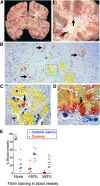Loss of endothelial protein C receptors links coagulation and inflammation to parasite sequestration in cerebral malaria in African children
- PMID: 23741007
- PMCID: PMC3731936
- DOI: 10.1182/blood-2013-03-490219
Loss of endothelial protein C receptors links coagulation and inflammation to parasite sequestration in cerebral malaria in African children
Abstract
Cerebral malaria (CM) is a major cause of mortality in African children and the mechanisms underlying its development, namely how malaria-infected erythrocytes (IEs) cause disease and why the brain is preferentially affected, remain unclear. Brain microhemorrhages in CM suggest a clotting disorder, but whether this phenomenon is important in pathogenesis is debated. We hypothesized that localized cerebral microvascular thrombosis in CM is caused by a decreased expression of the anticoagulant and protective receptors thrombomodulin (TM) and endothelial protein C receptor (EPCR) and that low constitutive expression of these regulatory molecules in the brain make it particularly vulnerable. Autopsies from Malawian children with CM showed cerebral fibrin clots and loss of EPCR, colocalized with sequestered IEs. Using a novel assay to examine endothelial phenotype ex vivo using subcutaneous microvessels, we demonstrated that loss of EPCR and TM at sites of IE cytoadherence is detectible in nonfatal CM. In contrast, although clotting factor activation was seen in the blood of CM patients, this was compensated and did not disseminate. Because of the pleiotropic nature of EPCR and TM, these data implicate disruption of the endothelial protective properties at vulnerable sites and particularly in the brain, linking coagulation and inflammation with IE sequestration.
Figures





Comment in
-
The endothelial protein C receptor and malaria.Blood. 2013 Aug 1;122(5):624-5. doi: 10.1182/blood-2013-06-508531. Blood. 2013. PMID: 23908442
Similar articles
-
The endothelial protein C receptor and malaria.Blood. 2013 Aug 1;122(5):624-5. doi: 10.1182/blood-2013-06-508531. Blood. 2013. PMID: 23908442
-
Plasmodium falciparum picks (on) EPCR.Blood. 2014 Jan 9;123(2):163-7. doi: 10.1182/blood-2013-09-521005. Epub 2013 Nov 18. Blood. 2014. PMID: 24246501 Free PMC article. Review.
-
Activated Neutrophils Are Associated with Pediatric Cerebral Malaria Vasculopathy in Malawian Children.mBio. 2016 Feb 16;7(1):e01300-15. doi: 10.1128/mBio.01300-15. mBio. 2016. PMID: 26884431 Free PMC article.
-
Binding Heterogeneity of Plasmodium falciparum to Engineered 3D Brain Microvessels Is Mediated by EPCR and ICAM-1.mBio. 2019 May 28;10(3):e00420-19. doi: 10.1128/mBio.00420-19. mBio. 2019. PMID: 31138740 Free PMC article.
-
Thrombomodulin-protein C-EPCR system: integrated to regulate coagulation and inflammation.Arterioscler Thromb Vasc Biol. 2004 Aug;24(8):1374-83. doi: 10.1161/01.ATV.0000134298.25489.92. Epub 2004 Jun 3. Arterioscler Thromb Vasc Biol. 2004. PMID: 15178554 Review.
Cited by
-
Brain swelling is independent of peripheral plasma cytokine levels in Malawian children with cerebral malaria.Malar J. 2018 Nov 26;17(1):435. doi: 10.1186/s12936-018-2590-0. Malar J. 2018. PMID: 30477519 Free PMC article.
-
Transdermal glyceryl trinitrate as an effective adjunctive treatment with artemether for late-stage experimental cerebral malaria.Antimicrob Agents Chemother. 2013 Nov;57(11):5462-71. doi: 10.1128/AAC.00488-13. Epub 2013 Aug 26. Antimicrob Agents Chemother. 2013. PMID: 23979751 Free PMC article.
-
Vascular dysfunction as a target for adjuvant therapy in cerebral malaria.Mem Inst Oswaldo Cruz. 2014 Aug;109(5):577-88. doi: 10.1590/0074-0276140061. Mem Inst Oswaldo Cruz. 2014. PMID: 25185000 Free PMC article. Review.
-
Exploiting polypharmacology to dissect host kinases and kinase inhibitors that modulate endothelial barrier integrity.Cell Chem Biol. 2021 Dec 16;28(12):1679-1692.e4. doi: 10.1016/j.chembiol.2021.06.004. Epub 2021 Jul 2. Cell Chem Biol. 2021. PMID: 34216546 Free PMC article.
-
Plasmodium falciparum erythrocyte membrane protein 1 variants induce cell swelling and disrupt the blood-brain barrier in cerebral malaria.J Exp Med. 2021 Mar 1;218(3):e20201266. doi: 10.1084/jem.20201266. J Exp Med. 2021. PMID: 33492344 Free PMC article.
References
-
- Murray CJ, Rosenfeld LC, Lim SS, et al. Global malaria mortality between 1980 and 2010: a systematic analysis. Lancet. 2012;379(9814):413–431. - PubMed
-
- Taylor TE, Fu WJ, Carr RA, et al. Differentiating the pathologies of cerebral malaria by postmortem parasite counts. Nat Med. 2004;10(2):143–145. - PubMed
-
- Grau GE, Craig AG. Cerebral malaria pathogenesis: revisiting parasite and host contributions. Future Microbiol. 2012;7(2):291–302. - PubMed
Publication types
MeSH terms
Substances
Grants and funding
LinkOut - more resources
Full Text Sources
Other Literature Sources
Miscellaneous

